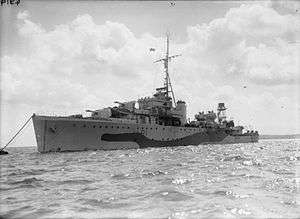Bittern-class sloop
The Bittern-class sloop was a three-ship class of long-range escort vessels used in the Second World War by the Royal Navy.
 HMS Stork in July 1943 | |
| Class overview | |
|---|---|
| Name: | Bittern class |
| Builders: |
|
| Operators: |
|
| Preceded by: | Kingfisher class |
| Succeeded by: | Egret class |
| Built: | 3 |
| Lost: | 1 |
| Retired: | 2 |
| General characteristics [1] | |
| Type: | Sloop-of-war |
| Displacement: | 1190 Tons |
| Length: | 266 ft (81 m) |
| Beam: | 37 ft (11 m) |
| Propulsion: |
|
| Speed: | 18.75-knot (34.73 km/h) |
| Complement: | 125 |
| Armament: |
|
Design
The Bittern class were built as light, long-range escort ships with limited anti-air capability. They were fitted with Denny-Brown fin stabilisers and a HACS fire control system.
Three ships were built: HMS Enchantress (originally called Bittern, but renamed before launching in 1934), HMS Stork and HMS Bittern. Enchantress was the first in the class, and was built as an armed Admiral's yacht. The armament was two single 4.7-inch guns forward and four 3-pounder saluting guns. Anti-aircraft armament was installed at the outbreak of war, however the aft turret, originally replaced with accommodation, was never installed.
Stork was unarmed on completion, but with provision for six 4-inch guns, plus AA and ASW weaponry; she served as a survey vessel in the Far East. Her main armament was added at the outbreak of war.
Bittern completed as designed, with the same armament as Stork[1]
The design served as the basis for the Egret and Black Swan-class sloops.
Ships in class
| Ship | Builder | Launched | Fate |
|---|---|---|---|
| Enchantress | John Brown Shipbuilding & Engineering Company Limited, Clydebank | 21 December 1934 | Sold 1946 |
| Stork | William Denny & Brothers, Dumbarton | 21 April 1936 | Broken up 1958 |
| Bittern | J S White & Company, Cowes | 14 July 1937 | Sunk by bombing off Namsos, Norway, 30 April 1940 |
Service history
Enchantress served as convoy escort throughout the war, and was credited with the destruction of an Italian submarine. She survived the war and was sold into civilian service in 1946, being renamed Lady Enchantress. She was broken up in 1952. Stork was completed as an unarmed survey vessel, and was only armed after the outbreak of war. She also served as a convoy escort, and was senior ship in 36th Escort Group under Cdr. FJ Walker. She was credited with the destruction of four U-boats. Stork remained in service until being broken up in 1958. The third ship in the class was launched as Bittern, and completed as designed. She was involved in the Norwegian campaign, but was lost to air attacks at Namsos in 1940.
Notes
- Conway's p57
References
- Brown, D.K. (2000). Nelson to Vanguard. Chatham Publishing.
- Gardiner, R; Gray, R, eds. (1985). Conway's All the World's Fighting Ships 1922-1946. ISBN 0-85177-245-5.
- Hague, Arnold (1993). Sloops: A History of the 71 Sloops Built in Britain and Australia for the British, Australian and Indian Navies 1926–1946. Kendal, England: World Ship Society. ISBN 0-905617-67-3.
External links
| Wikimedia Commons has media related to Bittern class sloops. |